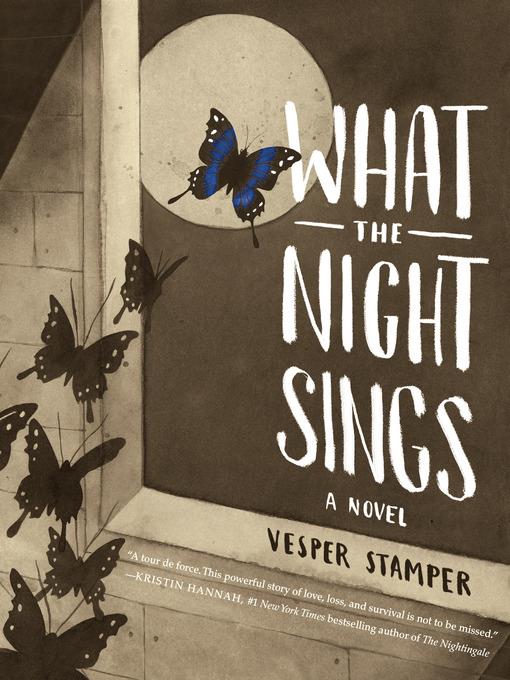
What the Night Sings
فرمت کتاب
ebook
تاریخ انتشار
2018
Lexile Score
720
Reading Level
3
ATOS
4.9
Interest Level
9-12(UG)
نویسنده
Vesper Stamperشابک
9781524700409
کتاب های مرتبط
- اطلاعات
- نقد و بررسی
- دیدگاه کاربران
نقد و بررسی

Starred review from November 20, 2017
Stamper’s exceptionally moving debut goes beyond recounting the suffering inflicted on Jews during the Holocaust to explore a young woman’s conflict between love and artistic ambition. Fourteen-year-old Gerta Richter, a talented singer and daughter of a violist in the Würzburg Orchestra, learned that she is actually Gerta Rausch, a Jew, when she and her father were forcibly removed from Würzburg by the Nazis one night in June 1944. The novel opens with the British liberation of German concentration camps in 1945 and moves smoothly among Gerta’s prewar life, her stay in concentration camps and the Bergen-Belsen Displaced Persons camp, and her postwar flight to Palestine. Focusing on Gerta’s transitional time as a displaced person, Stamper delves into her fight to regain her musical gift, her deepening relationship with a fellow survivor, her growing identity as a Jew, and her struggle to make decisions about her future. Generously illustrated with Stamper’s haunting spot images and larger scenes, all in deep brown hues that evoke profound emotion, the book is a strong addition to the bookshelf of Holocaust fiction. Ages 12–up. Agent: Lori Kilkelly, Rodeen Literary Management.

November 15, 2017
Gerta didn't know she was Jewish until she and her father were taken for transport by the Nazis.When Bergen-Belsen is liberated, Gerta and the other survivors are ill, skeletal, dying, or sunk in madness, and they have no homes to which they can return. Relating the events that led her there, she tells of a seemingly carefree life in Wurzburg with her musician father and German gentile stepmother, an opera singer who is also Gerta's voice teacher. But they were living with false identification papers, and their lives become ever more withdrawn. She has fleeting visions of her early childhood in Koln, of her mother, and of Kristallnacht. The cattle-car journey to Theresienstadt is only the beginning of days, weeks, months, years filled with unspeakable horrors in the "intricacies of the Nazi web...the animalization of human souls." Then comes Auschwitz, where her father is gassed, then Bergen-Belsen, typhus, and, finally, a kind of awakening to her own humanity. Later she covertly enters British-occupied Palestine, Eratz Yisrael, and builds a life there. Stamper spares readers nothing. Everything that Gerta witnesses or experiences really happened in the hell that was the Holocaust, including the further humiliations in its aftermath, a rarely told part of the story. The text is on pale, sepia-toned paper with dark, eerie illustrations in the same tones, reminiscent of real drawings produced by camp inmates.Evil that is impossibly difficult to comprehend and filled with word-images that will leave readers gasping. The author's dedication says it all, in both Hebrew and English: "Remember." (author's note, map, glossary, resources, acknowledgments; not seen) (Historical fiction. 14-adult)
COPYRIGHT(2017) Kirkus Reviews, ALL RIGHTS RESERVED.

February 1, 2018
Gr 7 Up-Fifteen-year-old Gerta Rausch did not know she was Jewish until the day she was picked up by the Nazis and taken to a concentration camp. She lived in Germany with her musician father and was sheltered from the reality outside her home, spending all of her time training in viola and opera. Gerta's father reveals the truth as they are crammed into a train car. Gerta struggles to accept this news; she knows nothing of Jewish traditions and her only experience with her religion is tied up with hatred, abuse, and slaughter. Being allowed to play in orchestras keeps her alive in both Auschwitz and Bergen-Belsen. Although the narrative describes life before liberation, much of it focuses on the postwar experience: life in concentration camps-turned-"displaced persons camps," lingering hostility toward Jews, as well as the grueling journey many Jews made from Europe to Palestine. The illustration style and muted color palette work beautifully with the text, managing to communicate both despair and hope. The narrative is spare but powerful as it depicts the daily horrors of the camps and the struggle to survive, hold on to humanity and, once freed, understand how to live again. VERDICT This powerful story is an excellent choice for any library.-Carla Riemer, Claremont Middle School, Oakland
Copyright 2018 School Library Journal, LLC Used with permission.

November 1, 2017
Grades 9-12 Before Nazis dragged Gerta Rausch and her father to the Theresienstadt ghetto and, ultimately, to Auschwitz, Gerta was different. Literally. According to her Ahnenpass, a certificate of Aryan lineage, she was Gerta Richter. She had no knowledge of her Jewish heritage; she also had a white-hot passion for all things music. Now, her familiarity with violaand enrollment in the Women's Orchestra of Auschwitzhas saved her life, but Gerta has yet to salvage her greatest love from the rubble: her singing voice. But one boy may be dead set on helping her find it. Sifting through the war's aftermath, Stamper's debut spotlights a multitude of oft-overlooked topics, from postwar pogroms and the Bergen-Belsen displaced-persons camp where Gerta resides, to the budding Zionist movement. Stamper's ethereal sepia-toned illustrations, teetering between black-and-white and full color, beautifully convey Gerta's dilemma as a girl on the brink of both adolescence and adulthood, friendship and romance, silence and song. A well-researched, elegant, and fittingly melodic exploration of reclaiming one's voiceand the many kinds of faith it can spark. Back matter not seen.(Reprinted with permission of Booklist, copyright 2017, American Library Association.)

























دیدگاه کاربران